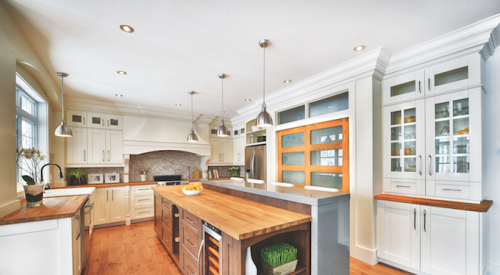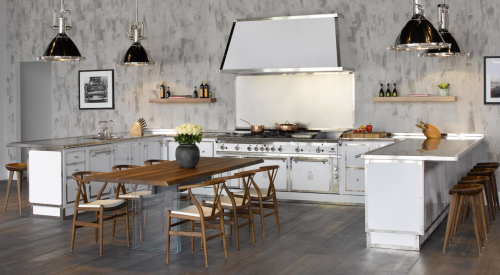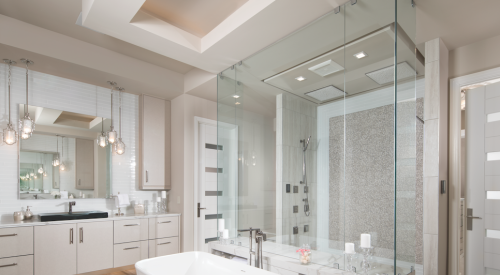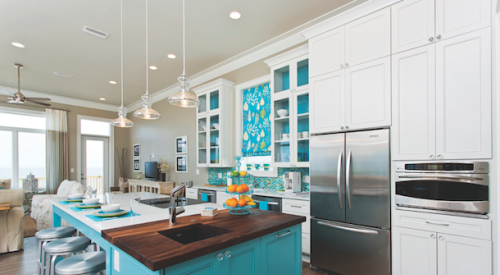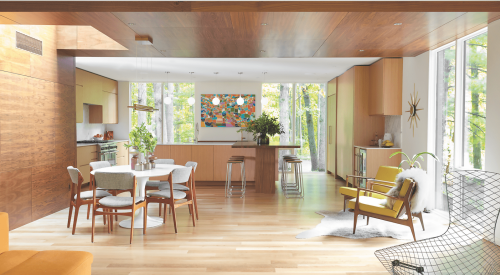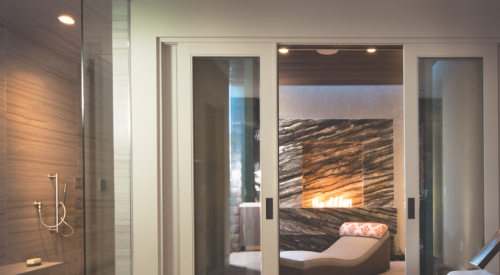|
No wonder today's kitchens are a feast of innovation and style: in houses, they're where the action is in houses. Americans spend "80 percent of their waking hours" in the kitchen, whether cooking, eating, doing homework, or entertaining guests, says Alan Hilsabeck Jr., CKD, CBD, ASID, of Premier Kitchens & Baths in Dallas. To meet the challenge of designing such hardworking spaces, designers have whipped up a recipe for kitchens that are as smart in function as they are in looks. It's the recipe for success in marketing and selling kitchens today.
Small or large, kitchens are being designed with several activity centers to serve many functions. "There are multiple zones and multiple appliances in those zones," says Mary Jo Peterson, CKD, CBD, CAPS, of Mary Jo Peterson in Brookfield, Conn. Most kitchens include more than one cooking center and at least two food prep areas — complete with sink, auxiliary refrigerator drawer, even secondary dishwasher or dishwasher drawer — so cooks easily work independently or share meal prep. A sit-down area with a roomy counter is set up as a computer center; kitchen designers are seeing a renewed interest in serious cooking, so homeowners are as likely to use the computer to download recipes and to pay bills. Kids may commandeer it at homework time. (The National Kitchen & Bath Association's new kitchen planning guidelines address the "new" kitchen, with recommendations for design and placement of multiple zones. See www.nkba.org.)
|
 Photo Courtesy of Toll Brothers
|
Eat-in kitchens still are a must, but with a difference. Breakfast nooks are out, says Hilsabeck. The nook is being absorbed into the main kitchen to enhance the sense of openness, and the eating area is moving to the kitchen island.
Island ParadiseWhat an island it is. "There's been a huge change to islands," says Martha Kerr, CMKBD, of the Neil Kelly Company in Portland, Ore. A far cry from the simple, utilitarian cooking island with downdraft vent, they're large, they're sculptural, they often look like furniture, and "they're useful on all four sides," Kerr says. "We are seeing more multifunctional islands that aren't filled up with cooking equipment, but [are] providing center stage for food prep." One or two sides of the island might be designed for chopping vegetables or baking, and others might work as a buffet or hobby center. Part of the island often is designed as a place where "guests might sit and visit with you" while you fix dinner, says Liz Firebaugh, CKD, of Signature Kitchens in Petoskey, Mich.
"We like to landscape islands," says Hilsabeck, who shapes them for aesthetics as well as function. He varies counter heights, for example, using a 42-inch-high counter as an eating bar and a 30-inch-high counter for a prep center or, with deeper knee space, a place to pull up a chair. The cook top may be 2 inches lower than the standard 36-inch counter to make it easy to see into pots. "Chefs call it cooking down on your food," Hilsabeck says.
Varied materials also dress up islands while defining zones, says Firebaugh. Granite remains popular for the food prep center, while a teak or other furniture quality wood surface becomes the dining "table." The wood is chosen to coordinate with the finishes in adjoining rooms or with the kitchen cabinets.
Simplicity Is InDon't expect cabinetry to be ornate. "We seem to be moving toward a simpler design ethic" in kitchens, says Peterson. Hilsabeck says the trend is strongest among homeowners 45 to 65 years old who are looking for simple, quality cabinetry that's good-looking and easy to maintain.
In door styles, the new simplicity translates into clean horizontal lines, says Peterson. Cabinet finishes have been toned down, too, says Firebaugh. Instead of dramatically distressed wood pocked with wormholes, for example, homeowners are opting for "just a stain with a glaze," she says.
Maple and cherry are the top wood choices, says Peterson. Homeowners in search of distinctive alternatives are requesting exotic species such as the strong-grained afromosia, says Firebaugh. "White seems to be popular again," adds Peterson, though now it's a rich white composed of layered stains, paints and glazes. "Every kitchen has two colors of cabinetry," she says, "a lighter wood or white, and a strong dark, even black."
The kitchen cabinetry may be simple, but that doesn't mean it is plain. Kerr's kitchen designs feature "more curves or radiuses in the cabinetry," often echoing curves in the island, she says. Cabinet suites may include a unit that looks like furniture — or actually is a piece of antique furniture — she says, "taking the focus off the functional look and creating a warm, welcoming space."
Complementing the cabinets are solid countertops. "Granite and engineered stone are still number one in our area," says Kerr. And stones such as slate, limestone, and soapstone are sought-after counter choices, says Peterson. Today's homeowners prefer a honed finish for the stone "because it is softer and without shine," says Firebaugh.
Kitchen sinks are getting simpler too. Replacing the double-bowl kitchen sink, there's "a trend toward a very large single bowl — even 36 inches," with a single pullout faucet, says Peterson. "Under-mount sinks are a standard," says Kerr. When Hilsabek's not installing these, he uses farmhouse, apron-front units that evoke a simpler time.
To capture light and connect with the outdoors, builders are adding windows and making them larger. That means less space for wall cabinets and a bigger job for base cabinets. Cabinet and drawer accessories "have gotten sophisticated" to enable base cabinets to do more, says Peterson. Inserts for supporting glasses and cups allow drawers to do the job once assigned to wall cabinets; pegboard systems keep dishes lined up in base cabinets; and pullout, pivoting units bring contents of low shelves into easy reach.
If space allows, home buyers still like having walk-in pantries to store food and kitchen equipment. But Hilsabeck often installs a "pantry wall" instead to make efficient use of former breakfast nook space.
What's Cooking in AppliancesDrawing from the menu of specialized appliances, designers are taking customization to a new level, creating kitchens that custom fit the home buyers' taste in cooking. "Steam cooking is trendy now" because of the interest in healthy cooking, says Kerr. She sees demand for both steam ovens and cook top steam units. European appliances, such as induction ovens, are gaining popularity in the United States after a slow start a few years ago, notes Hilsabeck. Cook top wok units are still popular, says Firebaugh. And Peterson finds more home buyers want microwave drawers. "They make a great work station under the counter in an island near the serving area, or under a cook top," he says. "Built-in coffee makers are all the rage, and wine chillers continue to hold their own," says Kerr. Warming drawers, once considered a luxury, have become "almost a staple, Hilsabeck notes.
Small, drawer-style appliances are hot because they allow the kitchen to be "compartmentalized," says Peterson. They are being integrated into islands and cabinetry for "invisibility" as well as accessibility — a high priority for home buyers looking to age in place. Also being blended into the kitchen: flat screen televisions. Hilsabeck has integrated them into the cabinetry over the refrigerator, installed large screens on the wall surrounded by cabinets, and attached smaller, flip-down screens under wall cabinets.
At the other end of the spectrum and equally popular — especially in cold winter climates — are large, 36-inch and 48-inch ranges in settings designed as kitchen hearths. Trimmed with an eye-catching tile backsplash and capped by a custom hood, perhaps ornamented with molding to look like a mantel, the hearth becomes "the focal point of the room," says Kerr.
Finishing touchesMore than ever before, the decorative tile used around the kitchen has become an artistic high point. Everybody loves glass tiles because of their beautiful colors. "Glass mosaics are huge," Firebaugh says. Textured styles, neutral tone-on-tone designs, and metallic tiles with relief patterns also are top choices because they add pizzazz while complementing the appliances and cabinetry.
Another aesthetic highlight is kitchen lighting. As "a reaction to the Swiss cheese effect of recessed can lights," says Kerr, home buyers are using fewer cans, supplementing them with pendant lights that provide better task lighting and add an artistic dimension. The pendants often feature craftsman-style blown glass shades framed with oil-rubbed or brushed metal to match appliances and hardware in the room. There's also more under-cabinet task lighting and "increased interest in energy efficient lighting using fluorescents" that now are available in new, attractive styles, says Peterson.
The interest in energy efficiency extends to a preference for natural, environmentally friendly products for the kitchen. Joining wood, stone and stone-look porcelain tile as leading flooring choices are natural linoleum (Marmoleum), sustainable cork and bamboo, Peterson says. Kerr is seeing interest in cabinets with sustainable wheatboard cases and bamboo door facing. Conservation-oriented home buyers choose recycled products as well, such as terrazzo-look flooring, tile and countertops made with recycled glass.
Pulling It All TogetherHome buyers are making careful decisions about where and how to invest the dollars in their kitchens. "They are being safer with the materials that they are going to live with for longer," choosing neutral countertops, flooring and tile, says Kerr. But they are "much less afraid to introduce bold colors on walls," she says. Firebaugh agrees: people are taking "more risks with color," choosing reds, greens and yellows. As Kerr puts it, "In many ways it's about color these days."
No matter what kitchen style they're looking for, home buyers are doing extensive research before finalizing their kitchen plans. They bring books, design magazines and printouts from Web sites, and they ask for specific products and design features. "We help them pull the ideas together," says Firebaugh, and make choices if need be.
| Author Information |
| Wendy Jordan is a Washington, D.C.-based writer whose articles have appeared in Professional Remodeler. Cheryl Cullen is a Frankfort, Ill.-based writer whose articles have appeared in Professional Builder and Custom Builder. |
|




